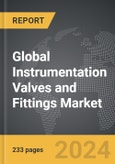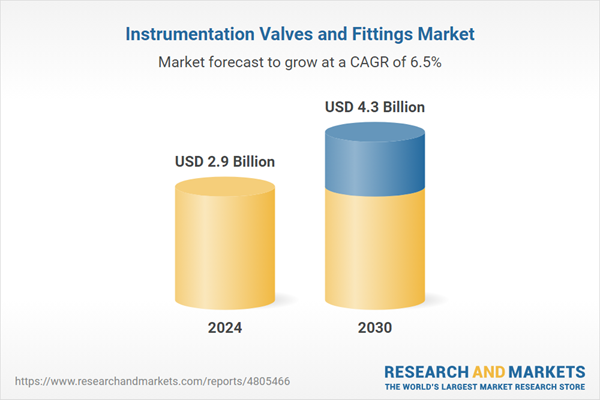Global Instrumentation Valves and Fittings Market - Key Trends & Drivers Summarized
What Are Instrumentation Valves and Fittings and Why Are They Critical?
Instrumentation valves and fittings are essential components used in the assembly and operation of instrumentation systems, particularly those involved in the monitoring and control of industrial processes. These components ensure the precise regulation, isolation, and direction of fluid flow within systems that require accurate measurements and control, such as in oil and gas production, chemical processing, and power generation. Instrumentation valves, including needle valves, ball valves, and check valves, are designed to provide tight sealing and reliable operation under varying pressures and temperatures. Fittings, on the other hand, connect different parts of the instrumentation system, ensuring leak-proof and secure connections. The reliability and performance of these valves and fittings are crucial for maintaining the accuracy and safety of instrumentation systems, making them indispensable in many industrial applications.How Is the Instrumentation Valves and Fittings Market Evolving with Technological Advances?
The market for instrumentation valves and fittings is evolving rapidly, driven by technological advancements and the increasing demand for high-performance materials. The development of advanced alloys and corrosion-resistant materials, such as stainless steel and exotic alloys like Inconel and Hastelloy, has significantly improved the durability and reliability of these components, especially in harsh environments like offshore oil rigs and chemical plants. Additionally, innovations in manufacturing processes, including precision machining and additive manufacturing, are enabling the production of valves and fittings with tighter tolerances and enhanced performance characteristics. The integration of smart technologies, such as sensors and actuators, into valves and fittings is also a growing trend, allowing for real-time monitoring and control, which is particularly valuable in automated and remote systems. These technological advancements are expanding the applications and capabilities of instrumentation valves and fittings, further driving market growth.Why Is There an Increasing Demand for Instrumentation Valves and Fittings Across Industries?
The demand for instrumentation valves and fittings is increasing across various industries due to the expanding scale and complexity of industrial operations. In the oil and gas industry, for instance, the need for precise control of fluid flow in both upstream and downstream processes is driving the demand for high-performance valves and fittings. Similarly, in the chemical industry, the handling of corrosive and hazardous fluids necessitates the use of valves and fittings made from specialized materials that can withstand extreme conditions. The power generation sector, particularly in nuclear and renewable energy facilities, also requires reliable instrumentation components to ensure the safe and efficient operation of critical systems. Moreover, the growing trend towards automation and the integration of smart technologies in industrial processes is leading to an increased demand for advanced valves and fittings that can support these modern systems.What Factors Are Driving the Growth in the Instrumentation Valves and Fittings Market?
The growth in the instrumentation valves and fittings market is driven by several key factors related to industry trends and technological advancements. First, the increasing adoption of automation in industries such as oil and gas, chemicals, and power generation is creating a strong demand for reliable and high-performance valves and fittings that can operate under automated control systems. Second, the expansion of industries that operate in harsh and corrosive environments, such as offshore oil production and chemical processing, is driving the demand for valves and fittings made from advanced materials that offer superior corrosion resistance and durability. Third, the growing focus on operational efficiency and safety in industrial processes is leading to increased investments in high-quality instrumentation components that can minimize the risk of leaks and failures. Additionally, the rise of smart technologies and the integration of sensors and actuators into instrumentation systems are boosting the demand for valves and fittings that can support real-time monitoring and control. These factors, combined with the ongoing development of new materials and manufacturing techniques, are expected to drive the continued growth of the instrumentation valves and fittings market.Report Scope
The report analyzes the Instrumentation Valves and Fittings market, presented in terms of units. The analysis covers the key segments and geographic regions outlined below.Segments: Product (Valves, Fittings, Pneumatic Actuators, Other Products); End-Use (Oil & Gas, Food & Beverage, Chemicals, Healthcare, Paper & Pulp, Energy & Power, Other End-Uses).
Geographic Regions/Countries: World; United States; Canada; Japan; China; Europe (France; Germany; Italy; United Kingdom; Spain; Russia; and Rest of Europe); Asia-Pacific (Australia; India; South Korea; and Rest of Asia-Pacific); Latin America (Argentina; Brazil; Mexico; and Rest of Latin America); Middle East (Iran; Israel; Saudi Arabia; United Arab Emirates; and Rest of Middle East); and Africa.
Key Insights:
- Market Growth: Understand the significant growth trajectory of the Valves segment, which is expected to reach US$1.9 Billion by 2030 with a CAGR of a 7.4%. The Fittings segment is also set to grow at 6.3% CAGR over the analysis period.
- Regional Analysis: Gain insights into the U.S. market, valued at $778.3 Million in 2024, and China, forecasted to grow at an impressive 10.6% CAGR to reach $983.8 Million by 2030. Discover growth trends in other key regions, including Japan, Canada, Germany, and the Asia-Pacific.
Why You Should Buy This Report:
- Detailed Market Analysis: Access a thorough analysis of the Global Instrumentation Valves and Fittings Market, covering all major geographic regions and market segments.
- Competitive Insights: Get an overview of the competitive landscape, including the market presence of major players across different geographies.
- Future Trends and Drivers: Understand the key trends and drivers shaping the future of the Global Instrumentation Valves and Fittings Market.
- Actionable Insights: Benefit from actionable insights that can help you identify new revenue opportunities and make strategic business decisions.
Key Questions Answered:
- How is the Global Instrumentation Valves and Fittings Market expected to evolve by 2030?
- What are the main drivers and restraints affecting the market?
- Which market segments will grow the most over the forecast period?
- How will market shares for different regions and segments change by 2030?
- Who are the leading players in the market, and what are their prospects?
Report Features:
- Comprehensive Market Data: Independent analysis of annual sales and market forecasts in US$ Million from 2024 to 2030.
- In-Depth Regional Analysis: Detailed insights into key markets, including the U.S., China, Japan, Canada, Europe, Asia-Pacific, Latin America, Middle East, and Africa.
- Company Profiles: Coverage of players such as Braeco, Bray International, Inc., Circor International, Inc., Dwyer Instruments, Inc., FITOK Inc. and more.
- Complimentary Updates: Receive free report updates for one year to keep you informed of the latest market developments.
Some of the 19 companies featured in this Instrumentation Valves and Fittings market report include:
- Braeco
- Bray International, Inc.
- Circor International, Inc.
- Dwyer Instruments, Inc.
- FITOK Inc.
- Ham-Let Group
- Hex Valves
- Hy-Lok Corporation
- Oliver Valves Limited
- Parker Hannifin Corporation
- Safelok Components Ltd.
- Ssp Fittings Corporation
- Swagelok Company
- Tylok International, Inc.
Tariff Impact Analysis: Key Insights for 2025
Global tariff negotiations across 180+ countries are reshaping supply chains, costs, and competitiveness. This report reflects the latest developments as of April 2025 and incorporates forward-looking insights into the market outlook.The analysts continuously track trade developments worldwide, drawing insights from leading global economists and over 200 industry and policy institutions, including think tanks, trade organizations, and national economic advisory bodies. This intelligence is integrated into forecasting models to provide timely, data-driven analysis of emerging risks and opportunities.
What’s Included in This Edition:
- Tariff-adjusted market forecasts by region and segment
- Analysis of cost and supply chain implications by sourcing and trade exposure
- Strategic insights into geographic shifts
Buyers receive a free July 2025 update with:
- Finalized tariff impacts and new trade agreement effects
- Updated projections reflecting global sourcing and cost shifts
- Expanded country-specific coverage across the industry
Table of Contents
Companies Mentioned (Partial List)
A selection of companies mentioned in this report includes, but is not limited to:
- Braeco
- Bray International, Inc.
- Circor International, Inc.
- Dwyer Instruments, Inc.
- FITOK Inc.
- Ham-Let Group
- Hex Valves
- Hy-Lok Corporation
- Oliver Valves Limited
- Parker Hannifin Corporation
- Safelok Components Ltd.
- Ssp Fittings Corporation
- Swagelok Company
- Tylok International, Inc.
Table Information
| Report Attribute | Details |
|---|---|
| No. of Pages | 233 |
| Published | April 2025 |
| Forecast Period | 2024 - 2030 |
| Estimated Market Value ( USD | $ 2.9 Billion |
| Forecasted Market Value ( USD | $ 4.3 Billion |
| Compound Annual Growth Rate | 6.5% |
| Regions Covered | Global |









